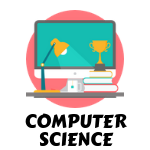12th Class Computer Notes All Chapters. We have uploaded the best quality ICS computer book in this series pdf which covers the new curriculum requirements of all the boards of Punjab. Because these notes are of high-quality format, you can easily print them and prepare yourself for the exams. These notes are divided into three parts.12th Class Computer Notes 2023 All Chapters
The first category contains comprehensive computer science notes for class 12. In this section, these notes include detailed notes on each of the second-year computer science topics. We have also included the resolved exercises and important questions at the end of these notes.
The second and third categories consist of fully solved exercises, MCQs, and short questions. We also added additional MCQs and short questions to cover each topic. You don’t have to buy an expensive book to prepare for the second year of computer science. These notes are completely free to use. You can share these notes with your friends or print notes on ICS Part 2 computer.
Finally, we do our best to help you by providing them with the best quality educational resources. But if you find an error in our second-year computer science note, please let us know. And, if you like our work, tell your friends too, so that they can get high marks in the FSC exam too. If you have any questions, please comment below. Share it because “sharing is caring”.
Chapter 1: Introduction to Computers
Computers have become an integral part of our lives, revolutionizing the way we work, communicate, and access information. In this chapter, students will learn about the fundamentals of computers, including their history, components, and basic operations. They will gain an understanding of how computers process data and the importance of computer literacy in today’s society.
Chapter 2: Computer Hardware
The second chapter focuses on computer hardware, which refers to the physical components that make up a computer system. Students will explore the various hardware components such as the central processing unit (CPU), memory, storage devices, input devices, and output devices. Detailed explanations and diagrams will help students grasp the functioning and interconnection of these components.
Chapter 3: Software Concepts
Software is the backbone of any computer system. This chapter delves into the world of software, covering topics such as operating systems, application software, and programming languages. Students will understand the different types of software and their role in enabling users to perform tasks efficiently. We provide in-depth explanations and examples to enhance students’ comprehension.
Chapter 4: Data Representation and Computer Arithmetic
Data representation is crucial in computing, as it involves how information is stored and processed in a computer system. This chapter introduces students to binary, decimal, and hexadecimal number systems, along with conversions between them. It also covers computer arithmetic operations, including addition, subtraction, and multiplication. Our comprehensive notes help students grasp the foundations of data representation and arithmetic.
Chapter 5: Computer Networks
In the era of global connectivity, computer networks have become essential for communication and data exchange. This chapter explores the basics of computer networks, including network types, network topologies, and network protocols. Students will learn about the Internet, its services, and the challenges associated with network security. We provide practical examples to reinforce their understanding.
Chapter 6: Database Management Systems
Databases play a crucial role in organizing and managing vast amounts of information. This chapter introduces students to database management systems (DBMS) and their significance in modern computing. They will learn about data models, relational databases, and the Structured Query Language (SQL). Our detailed notes cover topics such as data normalization, entity-relationship diagrams, and database transactions.12th Class Computer Notes 2023 All Chapters
Chapter 7: Boolean Algebra and Logic Gates
Boolean algebra and logic gates are fundamental concepts in digital electronics. In this chapter, students will explore Boolean algebra, logic gates, and their applications in designing digital circuits. They will gain insights into Boolean operations, truth tables, and logic gate implementation. Our comprehensive explanations and visual aids aid students in understanding the intricate world of digital logic.
Chapter 8: Computer Security and Ethics
As technology advances, the importance of computer security and ethics grows exponentially. This chapter addresses the various aspects of computer security, including threats, vulnerabilities, encryption, and authentication. Students will also delve into ethical issues related to technology, such as privacy, intellectual property, and cybercrime. Our notes provide practical advice on staying safe in the digital realm.visit ilmwap,.com for download notes
Chapter 9: Introduction to Python Programming
Python has emerged as a versatile and popular programming language. This chapter serves as an introduction to Python programming for students. They will learn the basics of Python syntax, data types, variables, control structures, functions, and file handling. Our step-by-step explanations and coding examples enable students to grasp the fundamentals of Python programming effectively.
Chapter 10: Web Development Fundamentals
The web has become an integral part of our lives, and understanding web development is essential. This chapter introduces students to web development fundamentals, including HTML, CSS, and JavaScript. They will learn how to create web pages, apply styles, and add interactivity using JavaScript. Our comprehensive notes guide students in building their first web applications.
Chapter 11: Object-Oriented Programming with Java
Object-oriented programming (OOP) is a powerful paradigm widely used in software development. This chapter focuses on OOP concepts using the Java programming language. Students will learn about classes, objects, inheritance, polymorphism, and encapsulation. Our detailed examples and explanations help students master the principles of OOP and apply them in real-world scenarios.
Chapter 12: Emerging Technologies
The field of technology is constantly evolving, giving rise to exciting emerging technologies. In this chapter, students will explore cutting-edge technologies such as artificial intelligence (AI), machine learning (ML), blockchain, and the Internet of Things (IoT). They will understand the potential of these technologies and their impact on various industries. Our comprehensive notes shed light on the future of technology.
